You can protect your garden from aphids by planting aromatic herbs like chives, garlic, and onions that release sulfur compounds these pests dislike. Marigolds create effective protective barriers with their strong scents, while catnip, basil, and spearmint provide additional deterrent properties. Companion plants like dill and fennel attract beneficial predators such as ladybugs and parasitic wasps that naturally control aphid populations. Strategic placement of these plants throughout your garden maximizes their protective coverage and effectiveness against infestations.
Understanding Aphid Behavior and Natural Deterrents
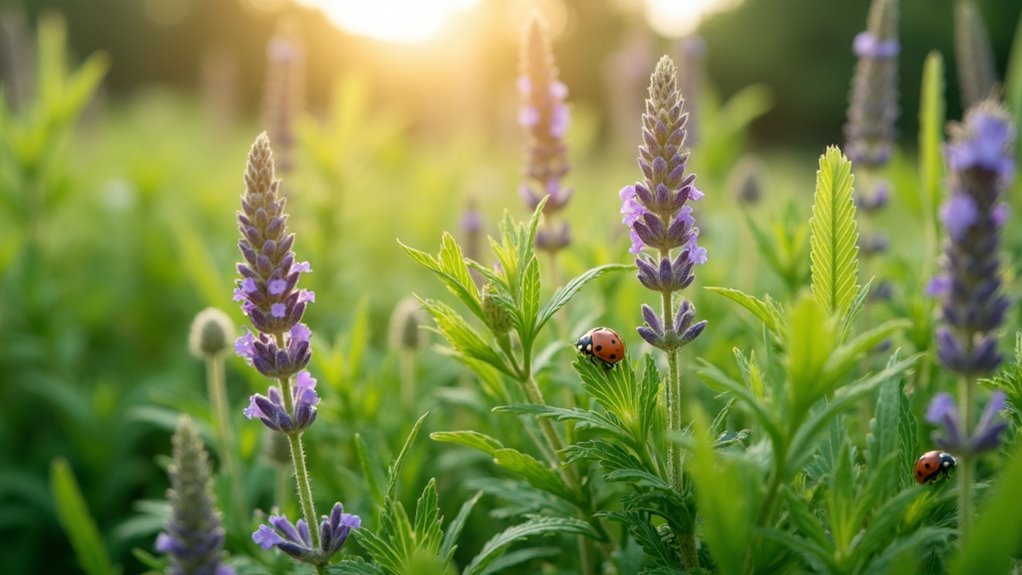
Since aphids multiply rapidly and target your garden’s most tender growth, understanding their behavior becomes essential for effective natural control.
These soft-bodied pests congregate in large numbers on succulent new shoots, creating dense colonies that can quickly damage plants. However, their clustering behavior actually works against them when you implement natural deterrents.
Companion plants offer an effective solution by disrupting aphids’ ability to locate and settle on their preferred hosts.
These pests rely heavily on scent to find suitable plants, making them particularly vulnerable to species that emit strong, repelling odors.
Strategic companion planting creates natural barriers that confuse aphids and make your garden less appealing to them, while simultaneously fostering beneficial insects that help maintain ecological balance.
Aromatic Herbs That Drive Aphids Away
You’ll find that aromatic herbs offer some of your garden’s best defense against aphid invasions through their natural scent compounds.
The allium family leads this botanical army, with garlic, chives, and onions creating powerful protective barriers around vulnerable plants.
Strategic placement of these fragrant culinary herbs transforms your garden into a dual-purpose space that repels pests while providing fresh ingredients for your kitchen.
Allium Family Powerhouses
Nature’s most potent aphid deterrents come from the Allium family, where garlic, chives, and leeks pack a powerful punch against these garden pests.
These plants that repel aphids release sulfur compounds that effectively drive away unwanted insects while enhancing your garden’s ecosystem.
You’ll find chives particularly valuable since they self-sow aggressively, creating natural barriers around your vegetables while improving carrot flavor.
Plant garlic near susceptible crops to deter aphids and attract beneficial predatory insects that maintain ecological balance.
Leeks offer dual benefits—they’re excellent culinary additions that simultaneously repel aphids through their strong aroma.
Fragrant Culinary Deterrents
While alliums dominate the aphid-repelling arena, aromatic culinary herbs offer an equally powerful defense system that transforms your garden into a fragrant fortress.
These fragrant culinary deterrents serve dual purposes—enhancing your kitchen repertoire while protecting vulnerable plants from aphid invasions.
Fennel and dill excel as natural pest controllers, repelling aphids through their distinctive scents while simultaneously attracting beneficial predators like parasitoid wasps.
Cilantro’s delicate flowers become magnets for hover flies and beneficial wasps that actively hunt aphids.
When you strategically plant these aromatic herbs around susceptible crops, you’re creating protective barriers that discourage infestations naturally.
This companion planting approach boosts garden biodiversity, attracting essential pollinators while maintaining effective pest control.
Your garden becomes a self-regulating ecosystem where fragrant herbs work tirelessly to keep aphids at bay.
Strategic Planting Methods
Strategic placement transforms aromatic herbs into powerful aphid-defense networks that maximize their protective capabilities throughout your garden.
You’ll achieve ideal results by implementing companion planting techniques that position repelling herbs directly alongside susceptible plants. Place garlic, chives, and onions from the allium family around vulnerable crops to create natural barriers with their strong scents.
Position fragrant herbs like fennel, dill, and cilantro nearby to simultaneously repel aphids and attract beneficial insects that control pest populations. Incorporate catnip strategically to repel aphids while drawing cats for additional pest control.
Enhance your defense system by mixing repelling plants with trap crops like nasturtiums, creating thorough pest management that effectively reduces aphid infestations across your entire garden space.
Allium Family Plants for Aphid Prevention
Gardeners have discovered a powerful ally in the fight against aphids: the aromatic allium family. Allium family plants like garlic, chives, and leeks release sulfur compounds that effectively repel aphids and other garden pests through their natural chemical defense system.
You’ll find chives particularly valuable since they self-sow aggressively, creating a continuous supply of pest-deterrent foliage throughout your growing season.
Plant garlic near your aphid-susceptible crops to enhance their pest resistance—the strong odor naturally deters these harmful insects from settling on nearby plants.
Leeks offer dual benefits by repelling aphids while simultaneously improving overall plant health and growth conditions.
Marigolds and Other Flowering Deterrents
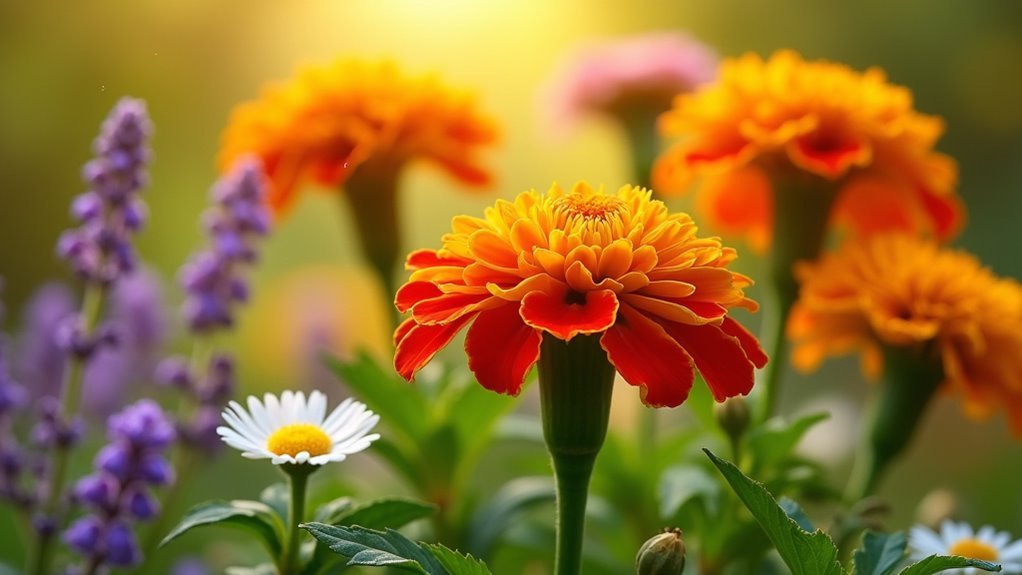
You’ll find that marigolds release a potent scent that naturally drives away aphids and other garden pests from your vulnerable crops.
When selecting companion flowers, consider catnip, garlic, fennel, and dill as they’re equally effective at repelling aphids while attracting beneficial insects like ladybugs and parasitoid wasps.
Strategic placement of these flowering deterrents throughout your garden creates a diverse ecosystem that’ll markedly reduce aphid infestations with minimal care requirements.
Marigold Scent Properties
When you plant marigolds around your garden beds, these vibrant flowers release a distinctive scent that naturally deters aphids and other harmful insects. This powerful aroma creates an effective protective barrier around your susceptible crops, helping you maintain healthier plants without chemical pesticides.
The scent properties of marigolds work exceptionally well to repel aphids through several mechanisms:
- Strong aromatic compounds mask the appealing scents of your target plants
- Natural chemical emissions confuse aphid sensory receptors
- Both French and African marigold varieties produce effective deterrent fragrances
- The scent intensity remains consistent throughout the growing season
- Beneficial insects like pollinators and predatory beetles aren’t deterred by marigold fragrances
You’ll find that strategically positioning these flowering deterrents maximizes their scent coverage while adding beautiful color to your garden landscape.
Companion Flower Choices
Beyond marigolds’ proven effectiveness, several other flowering companions create a thorough defense system against aphids in your garden.
You’ll find basil and spearmint release aromatic oils that repel these pests while adding culinary value to your space. Nasturtiums work double duty as both trap crops that attract aphids away from your vegetables and provide edible blooms for your kitchen.
For extensive protection, plant dill and yarrow throughout your garden beds. These companion flower choices attract predatory insects like ladybugs that naturally control aphid populations.
You’re creating a balanced ecosystem where beneficial insects thrive while harmful pests struggle to establish themselves. This diverse approach guarantees your vegetables stay protected while maintaining an attractive, functional garden that supports natural pest management through strategic companion planting.
Placement and Care
Strategic placement transforms marigolds and other flowering deterrents into a powerful defense network against aphids.
You’ll maximize their effectiveness by positioning these plants strategically throughout your garden space.
For ideal aphid protection, follow these placement and care guidelines:
- Border positioning – Plant marigolds along vegetable bed edges to create protective barriers
- Intersperse throughout – Scatter flowering deterrents like basil and spearmint among susceptible crops
- Regular deadheading – Remove spent blooms to promote continuous flowering and maintain pest-repelling properties
- Seasonal maintenance – Keep plants healthy through consistent watering and feeding
- Diverse plantings – Combine multiple flowering varieties to attract beneficial insects while repelling pests
This strategic approach guarantees your flowering plants maintain their protective qualities while supporting overall garden health throughout the growing season.
Trap Crops to Redirect Aphid Infestations
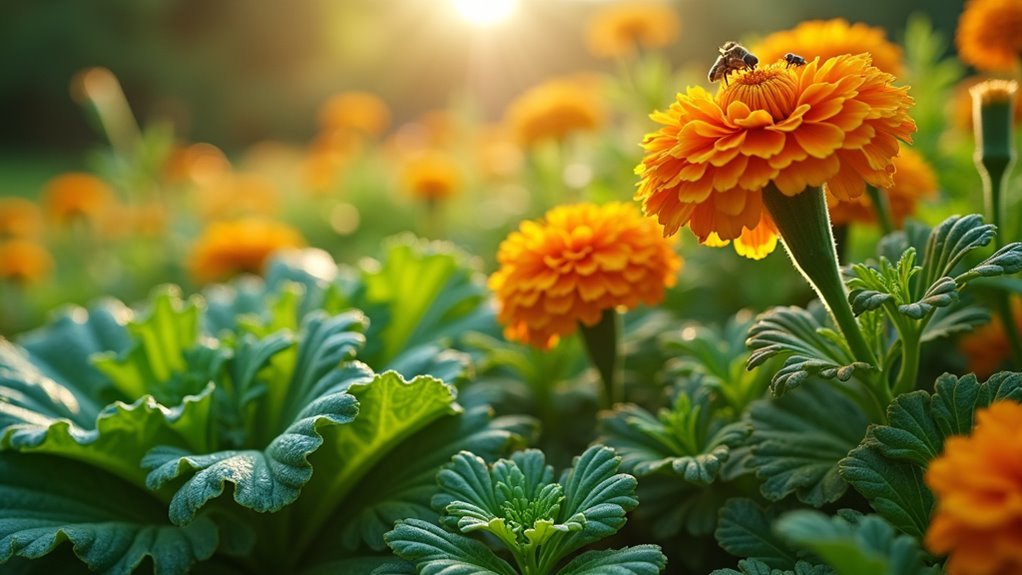
Since aphids can quickly overwhelm your prized vegetables and flowers, you’ll want to contemplate using trap crops as a clever diversion strategy.
These sacrificial plants attract aphids away from your valuable crops, concentrating infestations where you can easily manage them.
Radishes make excellent trap crops because they grow rapidly and feature low leaves that aphids find irresistible. You can quickly harvest and remove aphid-infested radishes from your garden.
Nasturtiums work similarly, drawing aphids while adding color to your landscape.
Sweet alyssum offers dual benefits—it attracts aphids while simultaneously drawing beneficial insects like bees for enhanced pollination.
Sunflowers serve as resilient trap plants that withstand heavy infestations without serious damage, making monitoring and management straightforward while protecting your more delicate plants.
Strategic Companion Planting Layouts
When you design your garden layout thoughtfully, you can create natural barriers that keep aphids away from vulnerable plants while supporting beneficial insects.
Strategic companion planting layouts work by combining repelling and trapping plants to establish a balanced ecosystem for controlling aphids naturally.
Here’s how to implement effective companion planting strategies:
- Plant alliums like garlic and chives near susceptible crops to create protective deterrent zones.
- Position marigolds and catnip around vegetables to form scent-based barriers against aphid invasions.
- Place nasturtiums away from valuable plants as trap crops to redirect and concentrate aphid populations.
- Incorporate sweet alyssum and borage to attract beneficial predator insects that’ll hunt aphids.
- Add clover and mint strategically to provide habitat for natural aphid enemies while controlling populations.
Plants That Attract Beneficial Predator Insects
While repelling plants form your first line of defense, attracting beneficial predator insects creates a powerful second wave of aphid control that’ll work around the clock in your garden.
Clover draws ladybugs and hoverflies directly to aphid colonies, while dill and fennel attract parasitic wasps that lay eggs on aphids for natural elimination.
Yarrow serves double duty by providing nectar for adult predators and attracting diverse beneficial species.
Mint brings in ladybugs and lacewings, both voracious aphid hunters that’ll patrol your plants continuously.
Sweet alyssum creates a pollinator haven that supports beneficial insect populations year-round.
These plants fundamentally recruit an army of natural pest controllers to attract beneficial predator insects that maintain equilibrium in your garden ecosystem.
Maintenance Requirements for Aphid-Repelling Plants
Although aphid-repelling plants provide natural pest control, they’ll only maintain their protective properties when you give them proper care and attention.
Proper maintenance and consistent care are essential for maximizing the aphid-repelling effectiveness of your natural pest control plants.
To keep aphids away effectively, you’ll need to follow specific maintenance practices for each plant type:
- Water chives and garlic regularly in well-drained soil, though they’ll tolerate drought once established.
- Deadhead marigolds consistently and plant them in full sun to promote continuous blooming and maximum repelling power.
- Trim catnip regularly to prevent invasive spread while providing moderate watering in full sun to partial shade.
- Prune fennel and dill frequently to prevent bolting in hot weather, maintaining their aphid-deterrent effectiveness.
- Plant alliums in fertile soil and harvest at various growth stages for continuous pest protection throughout the season.
Seasonal Timing for Optimal Companion Plant Establishment
Since successful aphid control depends heavily on timing, you’ll need to coordinate your companion plant schedule with both seasonal weather patterns and aphid life cycles.
Start by planting allium family members like garlic and chives in early spring when they establish quickly and effectively deter aphids from nearby crops. During this same period, sow fast-growing radishes as trap crops to lure aphids away from valuable plants.
In early to mid-spring, add fragrant herbs such as cilantro and dill to attract beneficial predatory insects.
Wait until late spring to introduce self-sowing annuals like sweet alyssum and nasturtium, which provide continuous seasonal blooms.
This strategic seasonal timing for ideal companion plant establishment guarantees maximum effectiveness against aphid populations throughout the growing season.
Combining Chemical-Free Methods With Plant Deterrents
When you integrate plant-based deterrents with other chemical-free approaches, you’ll create an all-encompassing defense system that maximizes your garden’s natural resistance to aphid invasions.
Strategic companion planting works best when combined with complementary organic methods that deter aphids naturally:
- Regular monitoring – Inspect plants weekly for early aphid detection and immediate intervention
- Physical barriers – Use row covers and reflective mulch to disrupt aphid movement patterns
- Water spraying – Deploy strong water jets to physically remove aphids from affected plants
- Beneficial insect habitats – Create diverse garden environments that support predatory insects alongside your deterrent plants
- Proper plant spacing – Maintain adequate air circulation to prevent humid conditions that attract aphids
This multi-layered approach guarantees your alliums, marigolds, catnip, dill, and cilantro work synergistically with other natural pest management strategies for maximum effectiveness.
Monitoring and Evaluating Your Natural Aphid Defense System
Your natural aphid defense system requires ongoing assessment to determine which strategies deliver the best results in your specific garden conditions. Start by regularly inspecting your plants for aphid indicators like curled leaves and sticky honeydew residue. You’ll also want to monitor beneficial insect populations, particularly ladybugs and lacewings, as they’re excellent natural predators.
| Monitoring Task | What to Look For | Frequency |
|---|---|---|
| Plant Inspection | Curled leaves, sticky honeydew | Weekly |
| Beneficial Insects | Ladybug/lacewing populations | Bi-weekly |
| Repellent Plants | Health of chives, garlic | Monthly |
| Trap Crops | Nasturtium effectiveness | Weekly |
Document your observations consistently, noting changes in aphid populations and overall plant health. This data helps you identify which natural defenses work best and when adjustments are needed for ideal pest management.
Frequently Asked Questions
What Is the Best Plant to Repel Aphids?
You’ll find garlic and chives are your best choices for repelling aphids. These allium family plants contain powerful chemical compounds and strong scents that effectively deter aphids from attacking your susceptible crops.
What Plants Are Most Aphid Resistant?
You’ll find Allium family plants like garlic and chives most aphid-resistant due to their strong scents. Marigolds, catnip, dill, fennel, and cilantro also naturally resist aphids while attracting beneficial predatory insects.
What Do Aphids Hate the Most?
You’ll find aphids hate strong scents most. They’re particularly repelled by allium family members like garlic and chives, plus fragrant herbs such as catnip, dill, fennel, basil, spearmint, and marigolds.
What Is a Natural Enemy of Aphids?
You’ll find ladybugs are one of aphids’ greatest natural enemies. Their larvae devour hundreds of aphids throughout their lifetime, making them incredibly effective biological control agents for your garden’s pest management needs.
In Summary
You’ll find that combining aromatic herbs, alliums, and marigolds creates a powerful natural defense against aphids. Don’t forget to establish your companion plants at the right time and maintain them properly throughout the season. You can enhance these plant-based deterrents with other chemical-free methods for maximum effectiveness. Monitor your garden regularly to evaluate how well your natural aphid defense system’s working and adjust as needed.

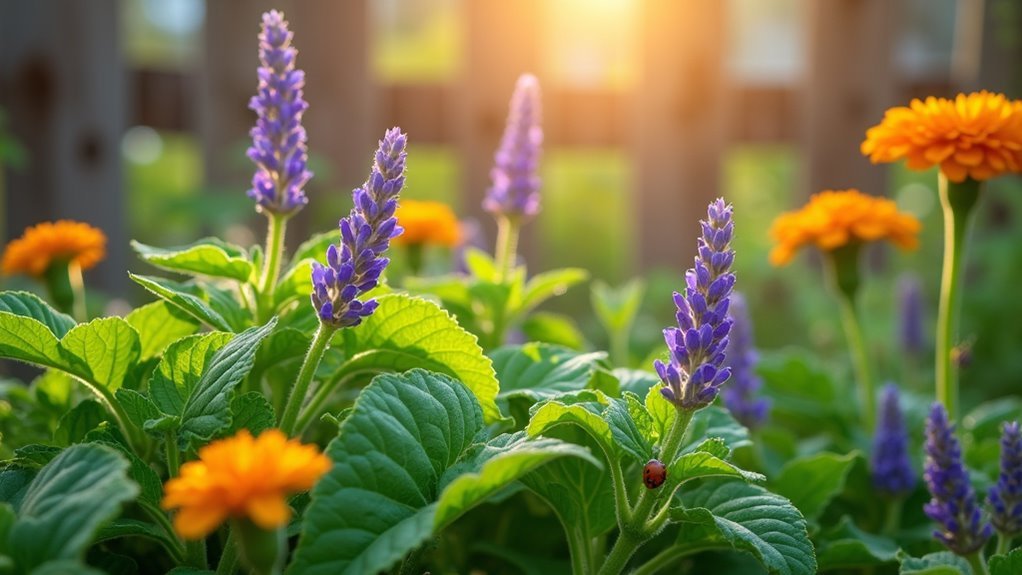
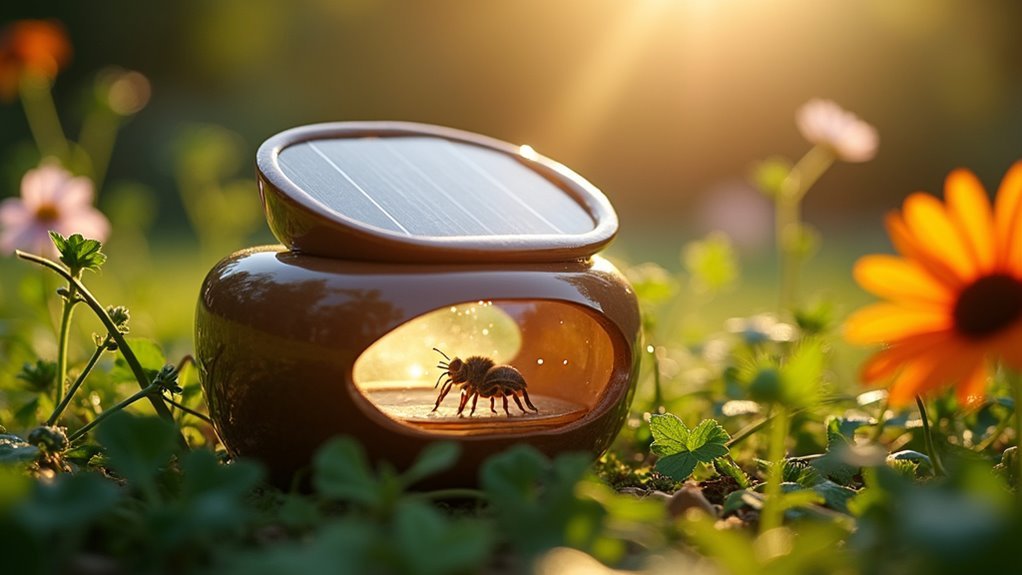
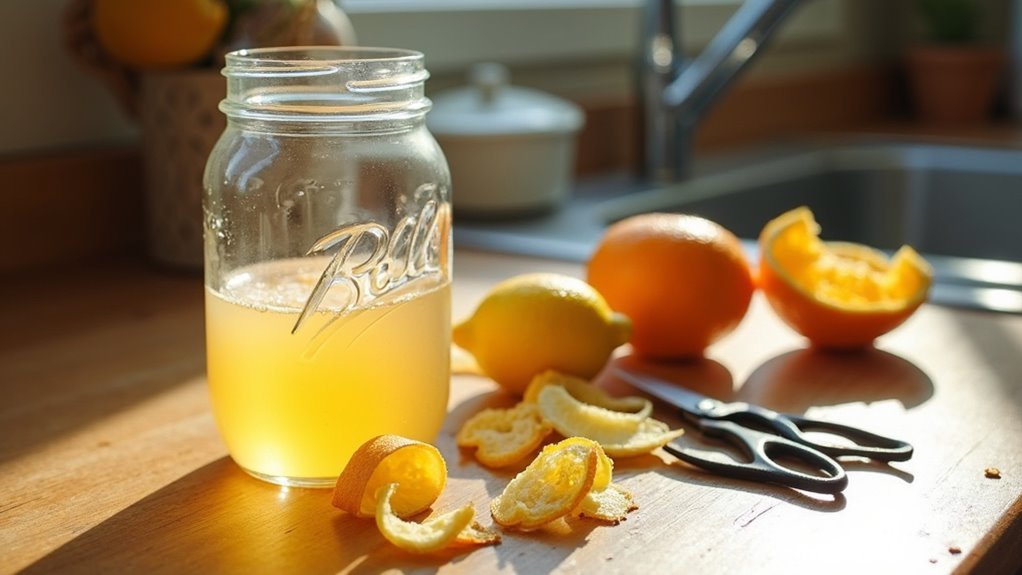

Leave a Reply